Chapter Twenty-Seven
The Mission Goes Global
Gurudeva’s global travels brought home to him the fact that Hinduism was a fragmented religion, each group isolated from every other group. He realized that this prevented Hinduism from realizing its inherent strength. As was his way, when he saw a need, he took well-planned steps to fulfill it. In 1995 he wrote: §
It was during a world tour through Singapore, Malaysia, Mauritius, Reunion, Africa, India, Nepal, Sri Lanka, Europe and other countries that I realized Hinduism had no global voice and no network of communication. The Hindus in Durban had no idea what was happening with Hindus in Colombo. Those in London had no connection with Hindus in Canada. Thus, I was divinely directed by inner orders from our Yogaswami Kailasa Parampara, by my satguru in this life, to fulfill the crying need to create an international network that would interconnect all Hindus into one invincible front.§
When I decided to launch HINDUISM TODAY in 1979, my thinking was: to make Saivism strong, we have to make all the other three main denominations strong. Because our philosophy is being devoted to Siva in everyone, we support every Hindu sect equally. Our strength is in having oneness with all the Hindus around the world, even though our philosophical, doctrinal and cultural approaches may differ somewhat. This is for the benefit of the overall Hindu renaissance, which is gaining in power as the century turns, for as each becomes strong, that strength benefits the overall body of Hinduism, giving pride, stability and courage to proceed with confidence. This is Hindu solidarity, one of our heartfelt commitments. The other is monistic theism—Advaita Ishvaravada—of Saiva Siddhanta.§
In June, 1980, Gurudeva and two swamis visited Malaysia for the first time. During their stay, several elders told them of a prophecy made almost 30 years earlier by a Malaysian sadhu named Sri Jeganathaswami that an American swami named “Subramaniam” would come to Malaysia to spread Saivism and Hinduism. Gurudeva didn’t suddenly take Malaysia by storm. In fact, he never took any place by storm. He sought no self-promotion, but rather worked to support and strengthen local religious leaders and institutions, according to their needs and not his ambitions. §
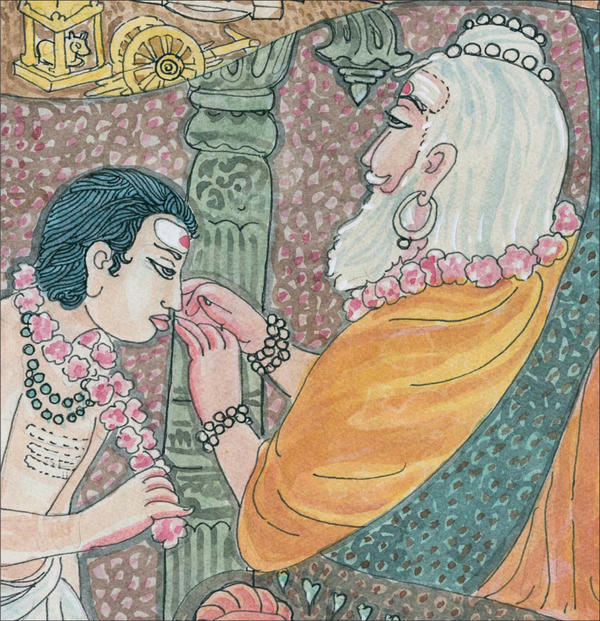
As Gurudeva began to craft a global fellowship of Saivites, the Hindus of Malaysia came forward powerfully. He visited often, guiding their spiritual learning and practice, giving diksha to the worthy.
• • • • • • • • • • • • • • • • • • • • • • • •§
Malaysia’s Hindu leaders had been feeling increasingly challenged on two fronts: the government of this predominantly Muslim country had been placing increasing restraints on their religion, while their youth had become fascinated with the Western lifestyle. The leaders were beginning to awaken the general Hindu community to these threats to their identity and future. Gurudeva gave form, style and impetus to this awakening as he traveled through the country and visited the major Hindu institutions—the Malaysia Hindu Sangam, the Kuala Lumpur Maha Mariamman Temple, the Ceylon Saivites Association, the Ramakrishna Mission, the Divine Life Society and others—to make friends. Especially drawn to him were those of the Tamil community. Many of Sri Lankan descent, particularly those who knew Yogaswami, made an easy connection. He was the guru they had been waiting for, one grounded in their Saiva heritage but totally at home with Western ways and idioms.§
The situation of Malaysian Hindus, just eight percent of the country, is different than that of Hindus in India. Government policies favor Islam and the bumiputras, Muslim native Malaysians, over the Indians and Chinese. As a result of this inequity, many Hindus—especially among the youth—had turned to their religion to strengthen self-identity.§
Malaysia was the first place in the world, for example, that Gurudeva ever met a youth group attached to a temple. This fine group of young men all wore jackets with “Siddhi Vinayaga Temple” on the back and worked as a team in selfless support of the temple’s care and management. Gurudeva was received enthusiastically by the younger generation, and he counted that a good sign. To his delight, they were ready to follow directions, a rarity among modern youth, and many were seriously committed to spiritual progress.§
Over the next few years, Hindus attracted to Gurudeva’s teachings held after-hours classes in Hinduism at local public schools. These popular seminars and the widespread distribution of HINDUISM TODAY magazine had a huge impact on Hindus in Malaysia. Many became dedicated members and, through the years, disseminated Gurudeva’s clear Hindu teachings to the youth. He spoke to their souls as no other had, to their contemporary ideals of religious life and service. Their own disciplined and successful lives served as a model; and more came, relieved to be part of a dynamic institution that instilled pride in the Hindu religion. §
He sent one of his monastics to teach classes all over the nation for nearly a year. In 1986 his devotees conducted successful Hindu youth camps in Malaysia, inspiring other Hindu organizations to put more emphasis on youth camps. When Gurudeva returned to Malaysia in the 1990s, his lectures were packed; and at his last book signing there, in 2000, over 800 people showed up, exceeding the hall’s capacity. Appasamy Kuppusamy writes:§
Once upon a time Gurudeva was ignored by many Hindus of Malaysia because he was white. But after getting to know him, the same people praised him for his services to Hinduism worldwide. At a national level, the cumulative impact of his work has been a dramatic increase in the pride of Hindus. §
Gurudeva’s publications have always been popular in Malaysia. In the 1980s, local devotees requested Gurudeva to write a book on Lord Ganesha, to explain this elephant-headed God to Hindus. They wanted it right away, to distribute at an upcoming festival; so Gurudeva and his monks created the entire book in eight days. That was a twelve-hour-a-day effort by a dozen monks; and the resulting book, Lord Ganesha, Benevolent Deity for a Modern Hindu World, was a success. The title alone was an inspiration to people. Later it was expanded into the even more popular Loving Ganesha. §
Each time Gurudeva visited Malaysia, he stopped in Singapore, where he nurtured a small group of followers and encouraged Hindu temples and organizations. His Malaysian and Singaporean devotees are among his staunchest and most active. Mr. Kuppusamy shared this testimony of Gurudeva’s impact on his life: §
At the beginning, I was not very serious about doing the sadhanas, the religious practices, but later I did do them seriously. I learned the atmartha puja for home worship and taught it to others. I and my wife, along with our ten-year-old son and twenty-two-year-old daughter, all became vegetarians without any reluctance. Gurudeva made me realize my mistakes, my bad karma done earlier in this life, and had me correct it through penance, prayashchitta. After that difficult penance, I am relieved and happy that this karma is gone. §
I thank Gurudeva because he changed our lifestyle. He taught us Hinduism. He taught us discipline. He made us see God everywhere, within and outside. He taught us to do thondu, religious service, all of which I am doing my level best to follow.§
Gurudeva spoke often on these topics, urging people to see God everywhere as a first solution to many of life’s problems:§
God has no names, but all names are the names of God. Whether you call Him this or that, He remains who He is. God is both within us and outside of us. Even desire, the fulfillment of desire, the joy, the pain, the sorrow, birth and death—this is all God, nothing but God. This is how God can be seen everywhere and in everyone. He is there as the Soul of each soul. You can open your inner eye and see Him in others, see Him in the world as the world. Little by little, discipline yourself to meditate at the same time each day. Meditate, discover the silent center of yourself, then go deep within, to the core of your real Being. Slowly the purity comes. Slowly the awakening comes.§
When problems come in the family or workplace and emotions arise, it is only natural to forget God. It’s so much easier to be involved in twoness rather than oneness. It takes a lot of inner strength to remember God all of the time, to keep the love for God flowing. We forget. We get involved in ourselves and others. It is impossible when our ego is attacked or our feelings hurt. So it’s easier, much easier, to forget God and even regard Him as a God to be feared; whereas it is our own instinctive mind and our pre-programmed, nonreligious intellect that should be feared. That’s the demon in our house, the mischief-maker who causes all the trouble. If you want to remember God, then first learn to forget yourself a little.§
It is natural to forget about God, but there are many helpful ways that we can avoid distraction, that we can remember to keep seeing God everywhere. One of the practical ways to bring God into the midst of all this is to keep repeating His name. Do japa when you find yourself forgetting, when you just can’t see God at all, let alone everywhere. When life becomes difficult or strained, mentally put it all at His feet. §
See Him in everyone that you meet or confront, regardless of the circumstances. He is there as their life force, but you just need to quiet the mind to see. Smile when you feel unhappy with someone and say to yourself, “How nice to see you, God, in this form.” Animals, beggars, princes, politicians, friends and enemies, holy men, saints and sages are all God to the soul that loves God. He smiles and thinks to himself, “How nice to see you, God, in this, another of your many forms.”§
God is love and nothing else but love. He fills this universe with love. He fills you with love. God is fire. God is earth. God is air. God is water. God is ether. God’s cosmic energy permeates everything and gives light and life to your mind. God is everywhere and all things. God is your small, insignificant worry, the concern that you have been holding in your mind for so many years. §
In His own way, He is bringing you into realization, into knowledge of yourself and of Him. He has given you the world of experience. Study your experience. Learn from your experience. If it is painful, that is also good. In the fires of experience, which are both pain and pleasure, you are being purified. In doing so, you must go through much pain, through much joy. Both register on the scale as the same intensity of emotion. It is what caused it that makes one more pleasurable than another. Don’t be afraid to live with God and go through your experience joyfully. Go through it with courage. Don’t try to avoid it.§
Saiva Periya Sangaratna Tan Sri Somasundram, president of the Malaysia Arul Neri Thirukkootam, wrote: §
Gurudeva avoided arguing the philosophies of the various sects of Hinduism. He showed the importance of religion, but not the arguments. He was not only the guru for a particular group of Saivites; he was accepted by all of us as a guru. If we are to respect him, we must live according to his teachings, to have peace in the world, peace at home, peace between husband and wife, peace everywhere.§
Mauritius: Island Jewel
For some unknown reason, Gurudeva’s influence had disproportionate impact on islands. It began in Sri Lanka, then extended to Kauai, Fiji and Trinidad. Mauritius, an island nation of one and a half million, of which fifty-two percent, including the ruling elite, are Hindu, would feel the grace of his holy feet. §
He was invited there by a Tamil elder and leading writer and thinker, Retnon Velvindron, who wrote to Gurudeva in 1981 saying he feared for the future of Hindu youth. They were being systematically converted by two other faiths, and their numbers were eroding at a fearsome rate. The Muslims had taken to converting those in financial straits, helping the jobless find work, helping the mortgage-challenged to keep their homes, all at a price. Salut et Guérison, the Mauritius mission of the Assembly of God, worked on those with health issues. They approached Mauritian Hindus who were sick or dying, befriended them and promised to pray for their recovery. If they did get better, bonds had been forged and friendships made, and formal conversion was soon to follow. The Tamil community of the nation was being particularly targeted, and Tiru Velvindron sought Gurudeva’s help to turn the tide. §
Gurudeva responded swiftly and with full force, flying with two swamis to the island nation in early 1982 after the India Odyssey. The receptions, while less populous than those that greeted him in Sri Lanka and South India weeks earlier, were equally loving and appreciative. His message was more bold than the normal Mauritian defenses of faith: Hinduism is the greatest religion in the world, the temples are the homes of the Gods and it is alright to turn missionaries away from your door and not let them in. In all nations, Hindus feel duty-bound to be hospitable even to those who would tear their families apart. The tall, white-haired guru from America made it okay to say no.§
Again in February of 1983, he flew there with two monks. This time he stayed a full month, one of his longest sojourns. A small guest house had been built especially for him at the Sri Sockalingam Meenakshi Temple in Port Louis. Gurudeva visited virtually every major Hindu community on the island, speaking with large crowds at temples, awakening the Mauritian youth to the grandeur of their religion. It was a turning point in the nation’s spiritual evolution. Gurudeva introduced his French-speaking monastic to one and all and arranged for him to remain in the country and teach Saiva Siddhanta classes for six months. These seminars were a grand success, leading eventually to the growth of Church membership and the founding of a seven-acre Spiritual Park and monastic center in the country. §
The Mauritius Spiritual Park started with a vision, which Gurudeva described in the following account. §
In 1986 I had a powerful vision of Lord Ganesha while I was here in Mauritius looking for property for Saiva Siddhanta Church. Lord Ganesha was walking from His temple attended by two priests. He was about to take a bath in the beautiful Indian Ocean in the country of Mauritius where the river meets the sea. I was standing in the water with several sharks swimming around me. Lord Ganesha, accompanied by two priests, looked at me and said, “Just rub some oil on their noses and they will not harm you.”§
The vision led me directly to this special land by the Rempart River and its lagoon. The Spiritual Park is a fulfillment of that vision. I see it combining environmental and architectural beauty that will give spiritual peace and mystical knowledge to visitors for many generations in the future. It is destined to become a pilgrimage site of great renown in the Indian Ocean area. Hindus from Malaysia, Singapore, Indonesia, Africa and India will come here.§
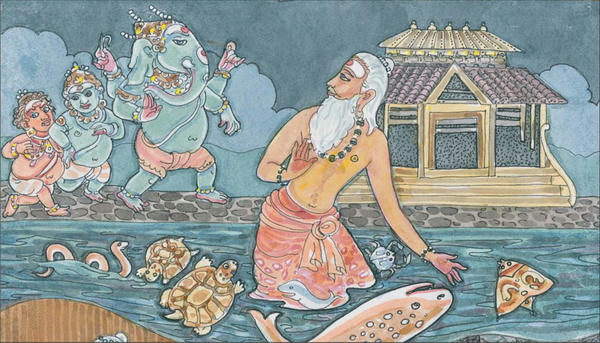
While looking for property for a center in Mauritius, Gurudeva had a vision of Lord Ganesha and a shark which took place in a river near the ocean. That vision guided him to the seven-acre, ocean-side parcel that would become the Spiritual Park.
• • • • • • • • • • • • • • • • • • • • • • • •§
Today thousands of Hindus attend the monthly homa at the Spiritual Park, burning their prayers in its magical fires. Outside the wooden, Kerala-style thatched pavilion, they crowd together in the shade of mango and sacred konrai trees to worship the nine-foot-tall black granite murti of Lord Ganesha with five faces and ten arms. In this way, Gurudeva’s mission took root on the tropical island that enchanted Mark Twain when he visited in 1896 and wrote, “You gather the idea that Mauritius was made first, and then heaven, and that heaven was copied after Mauritius.” §
Mauritius, basking peacefully in the Indian Ocean, is a land of pious temple worship for the general Hindu population. Almost every family there has been associated for generations with one of the thousands of local temples. Hindu celebrations like Mahasivaratri and Tai Pusam are grand events that often stop traffic with magnificent processions of thousands of people. For the average Hindu, basic religious obligations are fulfilled by participating in these festivals.§
An understanding of the significance of the Hindu guru was almost nonexistent in Mauritius until the 1980s, when Gurudeva first set foot upon this island. This spiritual innovator redefined the concept of Hinduism for many on the island. In the Mauritian nomenclature “Hindus” were the North Indians; the “Tamils” were regarded, and looked upon themselves, as a separate religious group. Gurudeva explained they were all Hindus, and these were just ethnic/linguistic divisions. This simple change of identity vitalized the inspiration of sincere seekers and began a new era in Mauritius—the era of Hindu unity and cooperation. Rajen Manick told of Gurudeva’s influence on his family: §
It was at this time that I first met Gurudeva. Although I had been studying his teachings through a correspondence course and writing for HINDUISM TODAY, my first encounter with him in person was a memorable experience. I could see immediately that he was not an ordinary man.§
He changed my life. The girl I was lucky enough to marry was also one of Gurudeva’s students. We were the very first of his devotees to be married in Mauritius. This happened in 1985. Our greatest joy has been to serve Gurudeva by imparting his teachings on the island of Mauritius, which we first did by organizing classes at local temples. §
After ten years of marriage we despaired of having children. Gurudeva taught us to face our karmas gracefully and to be humble in difficult situations. Shortly thereafter, most certainly with the blessings of Gurudeva, we had two children.§
During this time there was a regular flow of monastics traveling from Kauai Aadheenam to the monastery in Mauritius. Under Gurudeva’s direction they established the Spiritual Park and held retreats and seminars for thousands of youth around the island.§
Meanwhile, Gurudeva advised his family members on the island to use ayurvedic medicine and adopt a healthy diet, including raw sugar, brown rice and whole grain bread in place of white sugar, white rice and white flour. He encouraged followers to wear Hindu dress at home, in the temples and during festivals, even at work if employers allowed. §
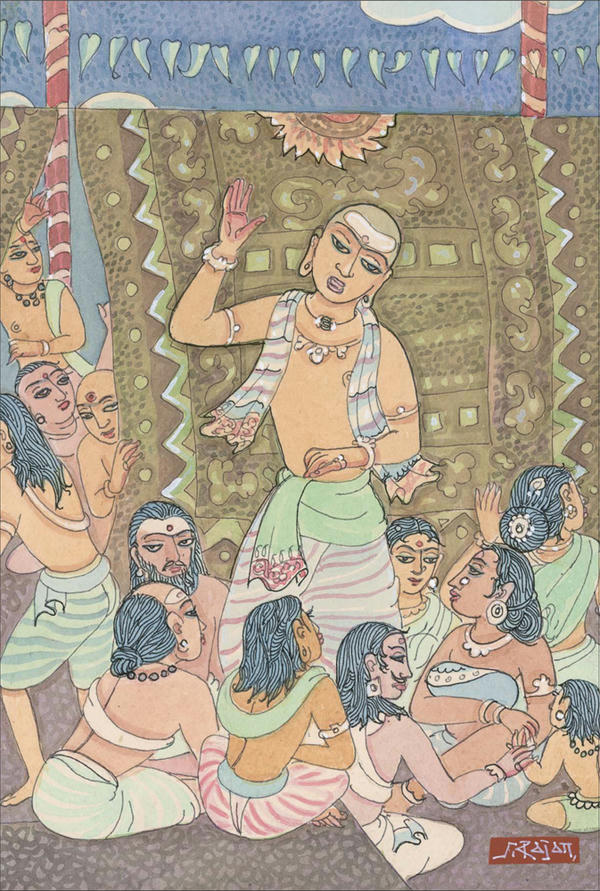
Seeing a dearth of Hindu missionaries during his wide travels, Gurudeva trained teachers and leaders to pass Saivite Hinduism on to the next generation. In Malaysia and Mauritius especially, his followers undertook to speak regularly to groups and families in temples, ashrams and homes.
• • • • • • • • • • • • • • • • • • • • • • • •§
Mougam Pareatumbee, a retired hotel chef, now manager of his own catering center, remembered how life was hard during the early days of his marriage, when his wife’s health seemed unfavorable for childbirth. One day, Gurudeva called from Hawaii and said, “I am with you. Don’t worry!” Soon his wife, Amutha, gave birth to two beautiful daughters. §
Accountant S. K. Moorghen remembers that prior to Gurudeva’s arrival in Mauritius, the importance of the home shrine was not fully understood. “Now,” he says, “even nonfollowers of Gurudeva make it a must to keep shrines in their homes, and they are proud of it.”§
Politicians like Anil Baichoo, Minister of Transport, affirmed that Gurudeva’s teachings in Mauritius helped to harmonize the various ethnic groups of the island: §
Gurudeva’s approach to Hinduism is not based on ethnicity or language. This has helped to build up more Hindu solidarity between Hindus of both North Indian and South Indian origin. Also, conversion is less of a problem in Mauritius, all due to the influence of Gurudeva and the Sai Baba groups.§
The story of Gurudeva’s influence on individuals, leaders and entire communities in Mauritius happened in other nations as well during these two decades, his years of strengthening Hindus worldwide. Similar tales are told by Hindus in Fiji and Germany, Trinidad and South Africa, Canada and Australia, Malaysia and the United States.§
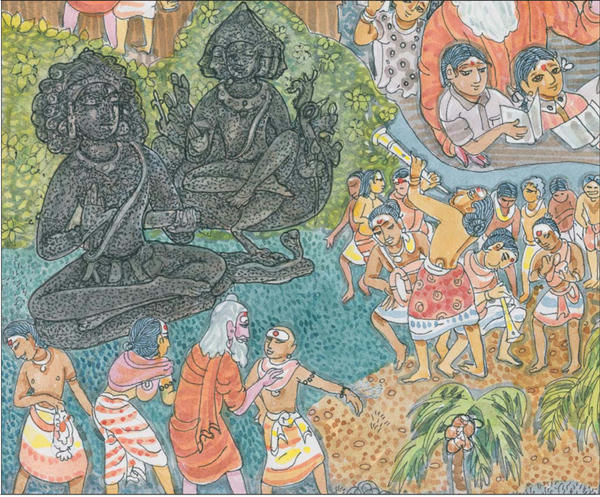
Gurudeva brought large murtis of Ganesha, Muruga and Siva to the Spiritual Park, and inspired Mauritian Hindus to learn and faithfully follow their religion. The pride he awakened forestalled Christian conversions and changed the island nation forever.
• • • • • • • • • • • • • • • • • • • • • • • •§
Guiding an International Congregation
By the mid 1980s Gurudeva had established a strong international congregation of men, women and children, the members of Saiva Siddhanta Church, striving for personal, spiritual transformation while living and working in the world, tithing on their income to support the Church, conclaving in local mission groups and gathering in homes to worship and perform karma yoga. §
From the early days Gurudeva was strict with himself and his monks and shishyas, and that strictness called for everyone to take vows. Vows, to him, were a way to build discipline and character and master the forces of mind, body and emotion, giving strength to face the future and holding the individual firmly on the path of sadhana. First there was the tithing vow. In the 80s vegetarianism was also required, and in the early 90s he added the vow of loyalty to the guru lineage. A few years before his passing, after discovering that some followers were still using physical punishment to discipline their children, he imposed a fourth vow, to be taken by all current and prospective members: the ahimsa vrata. Gurudeva explained the need and efficacy of vow-taking: §
Wholeheartedly accepting four vows—Ahimsa, Parampara, Shakahara and Dashama Bhaga—is essential to any aspiring student. The devonic adepts take these vows very seriously, knowing that once a vow is taken at an auspicious moment in life, the karmas yet to come change slightly to the positive side so long as the vow is upheld. But when vows are neglected, the full force of the held-back karmas not previously dissolved, mostly the bad ones, comes as a blow to individual, family and friends. So it is imperative that those who have taken these four first vows—Ahimsa, Shakahara, Parampara and Dashama Bhaga—receive help when needed from our mathavasis in fulfilling them.§
Because it has always been our aim to build a harmonious, productive, dynamic global fellowship, new candidates for membership and initiation are carefully screened and required to adjust themselves to the cultural standards, beliefs and attitudes that prevail at the time they seek entrance. They must be loyal and dedicated to our philosophy and goals, willing to blend their energies with the existing group of initiates to advance their own religious life and further the broader work of the fellowship. We are strict and demanding in order to build and maintain a core mission group. §
Moreover, steady improvement is expected from each member through the years. Each has come to me as a shishya for the sole purpose of performing sadhana. None is allowed to lose sight of his or her original intent. Initiates appreciate their life-changing moments and strive hard to keep up with the pace. §
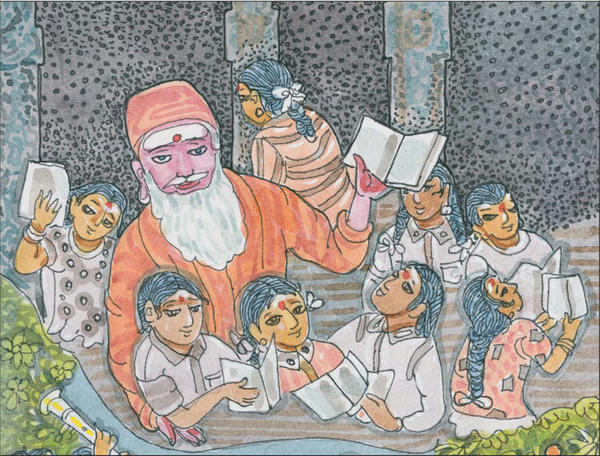
Children were dear to Gurudeva, and he worked hard to guide their upbringing, provide them with religious texts and protect them from harm. Thousands would grow up immersed in his teachings.
• • • • • • • • • • • • • • • • • • • • • • • •§
Gurudeva summarized the path of these tried and tested souls:§
If both husband and wife are on the spiritual path, the householder family will progress beautifully and deeply. Their love for one another and their offspring maintains family harmony. However, the nature of their sadhana and unfoldment of the spirit is different from that of the sannyasin. The struggle to maintain the responsibilities of the home and children while simultaneously observing the contemplative way, in itself, provides strength and balance, and slowly matures innate wisdom through the years.§
It is this balance that Gurudeva taught his householder devotees to accomplish, in his conversations with them and in Living with Siva, where he addressed every issue that arises on the family path, from the spiritually subtle to the most mundane. Deva Seyon, who lives near the monastery on Kauai, observed: §
Gurudeva brought the true and ultimate meaning of gotra, or family lineage, to his initiated devotees. While Gurudeva was the supreme monastic, he was never at a loss in advising on the business, social or intimate, personal problems of his initiated families, down to the smallest detail. He knew every family shishya on a deep, personal level—their hopes and dreams, fears and shortcomings—and never tired of guiding, helping and serving his congregation.§
Deva Rajan of California recalls just such an encounter: §
In the early 90s, we were having some financial difficulties in our business, Canyon Construction Company. I told Gurudeva about it and asked for his advice. He said. “Let’s go over to your office and you can tell me all about it.”§
It was a Sunday, so no one was there except us. He sat in the big swivel chair with a high back at my desk. I handed over the books of the business and he asked a few key questions. I showed him how we had borrowed over $140,000 from our business credit line just to pay bills, make payroll and taxes. Competition had driven our profit margins way down, and economic constraints at that time were not encouraging to clients. New projects seemed few and far between. I had no foreseeable way to pay off the debt.§
Gurudeva looked over everything closely and then with a warm smile of confidence, our business books in his lap, simply said, “Well, let’s just turn things around.” Then with a swift kick, he spun my chair around several times. Round and round he went, smiling all the while. Sitting on the floor in front of him, I pushed myself back, stunned and transfixed by the magic of these moments.§
When he finally came to a stop, he asked the monastic accompanying him to do a little puja and office blessing. The priest went around to every room and corner, clearing our business space with the wave of a bell, lamp and incense. At each window, he left a piece of fruit on the sill, asking any resident asuras to please enjoy the fruit, but also to please leave this office forever.§
Meanwhile, Gurudeva gave me some specific instructions about the business, ending with much encouragement and the words, “Proceed with confidence.”§
Within a few months, everything began to change for the better. Job after job came in. We expanded our business, hiring more personnel. Our debts were quickly erased, and profits began to accumulate such that we could continue to expand and grow out the business.§
After a few years, large, multi-million-dollar projects were knocking at our doors. We couldn’t seem to do anything wrong. At one point, a multi-millionaire invited us to build his $14-million estate on a 40-acre hilltop in nearby Oakland, California. Initially I turned him down, explaining that it was too big for us and that we had little experience at that level. He kept coming back, so I called Gurudeva to talk it over.§
Gurudeva was delighted with the prospects for our business and again poured on the encouragement to proceed with confidence. After we had signed the contracts, I called him with the good news and a question, “I’ve never built for such a rich man. What should I do?” Gurudeva said simply, “Just do what he says.”§
Those instructions may sound too simplistic, but I discovered them to be an essential key to working with this highly successful businessman and subsequently with all our clients. In our weekly meetings with him, I used to secretly take notes on every little thing that he or his wife would mention. I made sure that our management immediately fulfilled these requests and reported back to our clients that changes had been made or that specific instructions had been carried out. I watched as his architects would argue with him over design details. They were later fired. I instructed our management team and some eighty subcontractors working on the project to never argue or try to change the mind of our client. “Just do what he says,” I told them.§
During a thirty-year period, Gurudeva moved us from a small, struggling company to one of the most successful and respected contracting businesses in the San Francisco Bay Area. We took quantum leaps at times, to new levels of management and capacity, all the while under his guidance. He continually encouraged me to “reach for the stars,” sweeping away self-doubt and fears of failure. Yet, his advice was always rooted in simple basics.§
Though scattered across the globe, Gurudeva’s followers found themselves no less connected than if they lived in a single village. One example is the cross-national marriage that brought together the Deva Seyon family of Kauai and the family of Manon Mardemootoo, a leading lawyer in Mauritius. In 1991, Kavita, Deva’s daughter, married Sivakumaren, Manon’s son. Though half a world away, the two families merged like milk poured into milk. Deva recalled: §
Gurudeva’s constant blessings and loving care for the needs of our family led us to love and trust those who also loved him. His international global spiritual family became our family, as we shared the same goals and priorities in life. In amalgamating our two families, all the big issues regarding the future of our children were already settled, as we shared the same kulaguru.§
Gurudeva required his Church members to live strictly by the traditional, time-tested protocols of Tamil Saivite culture, which he detailed in his 365 Nandinatha Sutras in Living with Siva. Association with orthodox Saivites of India and Sri Lanka allows Westerners to absorb the subtleties and depths of this refined culture, and Gurudeva encouraged it at every opportunity.§
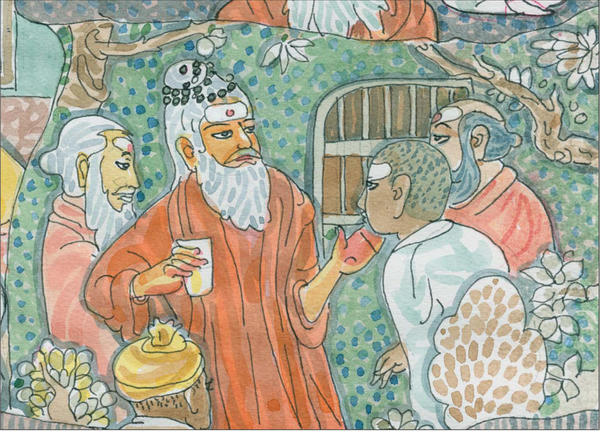
Following the daily pre-dawn meditation, it was common to find Gurudeva walking along Siva’s garden paths, coffee in hand, greeting monks and visitors alike, reminding one and all of their innermost Self.
• • • • • • • • • • • • • • • • • • • • • • • •§
Succinctly, boldly, these Nandinatha Sutras describe how people lived and interrelated with one another when life was simpler, when families and villages were close-knit, and love and peace, respect and wisdom prevailed. There is no new knowledge contained herein. Each sutra proclaims an ancient wisdom and protocol which, when followed, brings that same simplicity, community support, peace, harmony and refinement of enduring relationships into daily life. Each of these 365 sutras, one to be read each day of the year, is a thread of purity, many from the historic past into the present, some from contemporary times. Even today, in the fifty-second Hindu century, these precepts define the daily life of hundreds of millions of well-bred and well-raised Asian people. §
While they are law, these sutras are not commandments. They simply describe what devout Hindus do. Naturally, my expectations are that my close followers will heed and earnestly try to put into practice all 365 sutras. Many who read these sutras will wonder to themselves or even among friends, “Why do we need to follow such strict traditions and disciplines? Aren’t they a bit old-fashioned?” My answer is: before the two world wars, many traditions similar to these were followed even in the United States, regarding raising of children, man-and-wife relationships, women rarely working outside the home, and thus not neglecting their children, etc. It was during World War II, when women began working in the world, that the breakdown of traditional culture occurred, setting a trend that is now being followed in almost every nation. §
The nonculture, or the destruction of culture which is nonculture, has become the “culture” which everyone follows. Hence the avalanche of promiscuity, divorce, suicide, various excesses and abuses—murder, theft, wife-beating, drug abuse, unstable, ever-shifting cohabitation as a substitute for marriage and the shameful neglect of children. Everyone’s security is threatened. §
When my satguru, Sage Yogaswami, was asked half a century ago why we should follow the old ways, he answered simply, “The railway engine pulls many coaches. Can it do so if it runs off the track? No. Great people have shown the path. We must follow it.” Though perhaps challenging, the disciplines and guidelines described in the sutras create happy individuals, harmonious families and secure nations. When you take them as a total whole, you will glimpse the ideal community. Such a community is able to work together, love together, trust together, create together, serve Siva together, worship together, live together in a productive harmony and ongoing creativity, as they each experience birth, life, death and birth again. §
Hindus have spread throughout the world, relocating themselves because of employment opportunities, ethnic disputes, violence and economic deprivation within their homelands. Because of this diaspora, it has become necessary to restate the law of the culture, the protocol and modes of behavior that their forefathers knew and lived so well.§
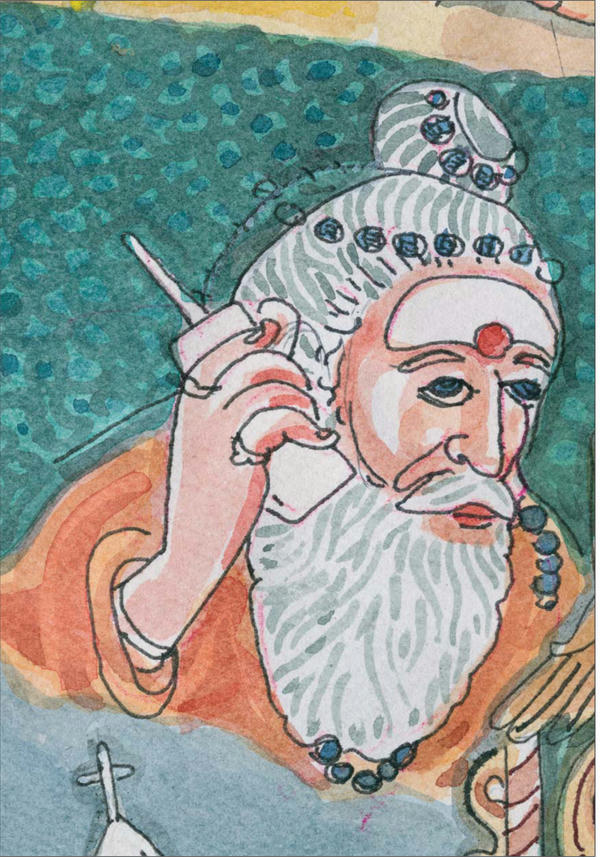
Gurudeva was available to devotees night and day, taking calls anytime of the day to discuss their health, family, jobs and meditations.
• • • • • • • • • • • • • • • • • • • • • • • •§
The Saivite Shastras, revealed to Gurudeva in 1973, explain, “The guru worked with the families in the same way he worked with a single monastery.” Deva Seyon elaborated on that relationship between the monastery and family homes: §
The monastery and the families of Saiva Siddhanta Church work closely together on many levels in fulfilling Gurudeva’s directives, both within the Church missions and with the public at large. The families learn by watching the monks—their attitudes, their commitment, their selfless service. §
This relationship is born out of the love of striving through daily religious disciplines, such as meditation and scriptural study, that Gurudeva nurtured in all of his devotees. §
Gurudeva urged the families of the Church to forge frontiers in passing on the traditions of the Hindu religion by worshiping daily together in the home shrine, wearing Hindu clothing, raising children nonviolently, holding daily family meetings and spending an evening together at home at least once a week. He taught groups of families in each area to collaborate and help each other live a meaningful Hindu lifestyle in many ways, such as homeschooling their children together, hosting pilgrims and special guests and going on pilgrimage together to temples in South India and to the Aadheenam in Kauai. §
Gurudeva put great emphasis on establishing a lay ministry, designating one or more couples in each Church mission as a kulapati family. Much of his work with the congregation, and with spiritual initiatives in many nations, was channeled through this hand-picked, highly trained group, his missionaries in the field whom he called upon almost daily.§
Manon Mardemootoo eloquently summarized Gurudeva’s impact on the lives of householder devotees: §
Gurudeva has exposed us to a way of life conducive to peace, love and harmony in and outside the home. He has given us the tools to be peacemakers, to shine as examples of good family people, and as elders who have been endowed with wisdom, able to stand as respected leaders even in the most difficult times. He has taught us by his own life how to be strong in our beliefs and values and succeed in life by planning carefully and living fully in the present. If we now enjoy daily the wonderful experiences of extended and joint families, and if we know how to protect and keep our culture and religion alive and prosperous, it is all thanks to our satguru.§
Gods in Exile
Gurudeva taught Hinduism to Hindus from the inside out, beginning with explanations of the deepest spiritual world. §
The Third World is where the highest beings, such as Lord Ganesha, Lord Murugan and our Great God Siva, exist in shining bodies of golden light. This Third World is called the Sivaloka. The Second World of existence, or astral plane, is called the Devaloka. The great Gods have millions of helpers in the Devaloka who help each and every one of us. One or more of them is assigned to personally help you in this First World, which is the world of material or physical existence, called the Bhuloka. §
He would then explain how the devas can see the sacred ash upon a person’s forehead, how they and the Gods can hear the Sanskrit chanting of the priest in the temple and how the stone icon of the Deity in the temple sanctum is like a telephone connection to the Third World of the Gods. A precious few in his audiences had heard such explanations from their grandmothers or grandfathers, but it was quite a different matter to hear Gurudeva teach from his own realization.§
He addressed a special part of his message to his fellow Saivites to dispel the common misconception that God Siva should not be worshiped in the home, and that the worship of Siva, who is incorrectly seen by many only as the God of Destruction, will make one poor. “Nonsense,” he retorted, “Lord Siva is the God of Love!” He explained that worship of Siva—the Creator, Preserver and Destroyer—will bring every benefit, including wealth. Thousands of Saivite families who, succumbing to the local superstitions, had been afraid to bring a simple Nataraja into their home, boldly brought the God of Love into their puja rooms. §
Gurudeva wanted all the Gods brought “out of exile” and encouraged Hindus of each sect to make their home shrine the most beautiful room in the house. He reserved a special censure for those Hindus who put their shrine in the closet, to be easily hidden when a guest visited. “Closet Hindus,” he would chide. For his followers, the house should proudly and openly reflect the religion and culture of its residents. It should be, in his words, “...an absolutely breathtaking home shrine, used solely for meditation and worship of Sivalingam, Nataraja, Murugan, Ganesha and the satguru’s tiruvadi. This is the home’s most beautiful room.” §
He began emphasizing the daily performance of puja in each and every home, in addition to meditation, which for decades had been the mainstay of his prescription for spiritual living. For those in the West, as well as the East, he had his monks put into writing the traditional home puja, which he had arranged for them to learn in the late 1970s. He published it as the Saiva Atmartha Puja—likely the first time it was ever made widely available—presenting the ancient Sanskrit chants, and providing English and Tamil translation and transliteration. §
Thoroughgoing in everything he did, Gurudeva drew deep from the well of Saivite liturgy to bring the ancient priestly magic into his own sanctuaries in 1982, asking Subramania Gurukkal to do something unheard of—convey the arts of temple puja, Saiva Parartha Puja, to his monks, which he did, in Alaveddy at the Sri Subramuniya Ashram. In 1985 Gurudeva had that knowledge bolstered by B. Shanmugam Sivachariyar, who flew to Kauai from South India to teach the monks the homa rites and patiently wrote out by hand the Parartha Puja in Devanagari and transliterated English. This was done with the blessings of Sambamurti Sivachariyar, head of the Then India Archaka Sangam.§
During the 1981 India Odyssey, while talking with an elite group of Tamil elders in Tiruchendur, Gurudeva said, “If you give up your temples and your religion, you will, within 50 years, lose your race.” On that same Innersearch, Mr. A. Gunanayagam, president of the Eelathu Thiruneri Thamil Mandram, gave a talk on behalf of the Mandram at the Saraswati Hall in Colombo, enumerating the activities and accomplishments of Saiva Siddhanta Church and lauding its service to Saivism: §
When the apostles of different faiths left the Western world in the 15th to the 19th centuries for the shores of the East, they believed they were following the true course of the river of spirituality, which to their mind was flowing from the West to the East. They genuinely felt they were carrying the torch of spiritual enlightenment to those that needed it. But the emergence of Swami Vivekananda set them thinking. Was not the flow of the river really from the East to the West? §
Now has come a third stage, with the blossoming of the Saiva Siddhanta Church of Hawaii. Is it not a near miracle being enacted before our very eyes? Has the river started to flow backwards? What we mean is, the once spiritually glorious East has dried up into insignificance except for a few oases here and there. The East has become insensitive to changing times and has failed to keep pace with the technological age. Lethargy and indifference have overpowered the rightful heirs of a golden heritage. It has therefore fallen to the lot of the Saiva Siddhanta Church to stand up for the greatest religion on Earth, both by precept and example. It is carrying aloft the torch of Saivism. §
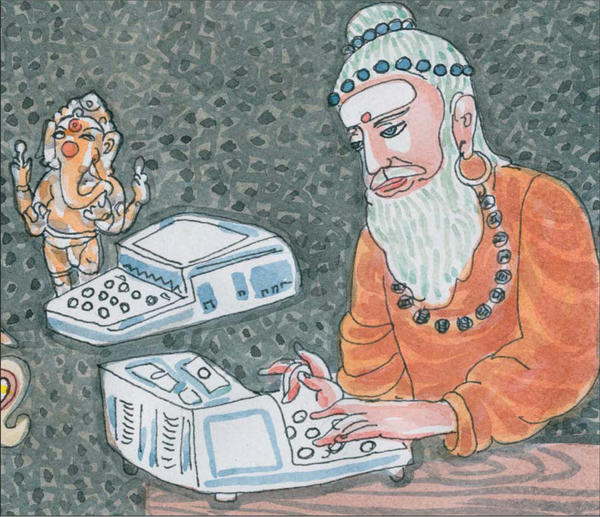
An early adopter of new technologies, Gurudeva was fond of tools that helped him capture and communicate ideas and writings—miniature recorders for voice notes and portable computers, like the innovative 1980 Sony Typecorder that recorded text to a cassette tape.
• • • • • • • • • • • • • • • • • • • • • • • •§
An earnest seeker cannot but sit at the feet of the Church to regain something of the glorious Saiva past. Such is the silent revolution that is being enacted in Hawaii. Otherwise, how can a 16-ton granite Nandi from Mahabalipuram be installed in the holy precincts of the Saiva Siddhanta Church in Hawaii? How can the six-foot Lord Nataraja take abode in the Kadavul Temple of Hawaii?…§
It is not only the ritual and ceremony concerning these that alone are fascinating, it is the underlying philosophy which the Church so assiduously puts across which is most inspiring. We lift our hands in homage and gratitude to you, Gurudeva, as the God-sent dynamic ambassador of Saivism, to the dedicated and selfless band of swamis and to the Saiva Siddhanta Church, with a prayer in our heart, that the great and good work of the Church may continue to edify and enlighten all mankind!Ӥ
Defending the Word Church
Back in 1975, Gurudeva had officially changed the name of his organization to Saiva Siddhanta Church, having recognized, through his years of study, the strategic value of that legal form of religious institution in the United States. It was not a popular choice for some. Objections came from many sides, especially, and understandably, from Hindus in Asia who did not like the association with the Catholic and Anglican churches, which they saw as the nemesis of Hinduism. But Gurudeva held his ground, and spent decades defending his decision. §
Ultimately, he would be proved right, but it was not an easy campaign. Members left him on this issue. But then, members also left him because they refused to stop smoking or refused to have their wives stay home and raise the children, or refused any number of the requirements he placed on dedication. In Saiva Dharma Shastras, the Book of Discipline of Saiva Siddhanta Church, composed in the early 90s, Gurudeva explains:§
The name of our Hindu church is Saiva Siddhanta Church, meaning “sacred congregation of Supreme God Siva’s revealed Truth.” These two Sanskrit words and one English word we consider to be our international trademark. §
No other terms should be substituted for the word church when writing or conversing in English. The word church may be translated into other languages for purposes of conversation. It may also be so translated for legal documents, such as for registration of mission groups, as deemed preferable by the parent Church. Such translations shall always use the official terms approved by the Church. In such translations, based on the pattern of well-established local churches, we choose words that most strongly convey this meaning: a one-minded, hierarchical body of devotees, following a single doctrine of belief, with strict codes of conduct, an initiated priesthood, ministry and missionaries, well-defined sacraments, shared scriptural authority and exclusivity of membership free of other alliances. §
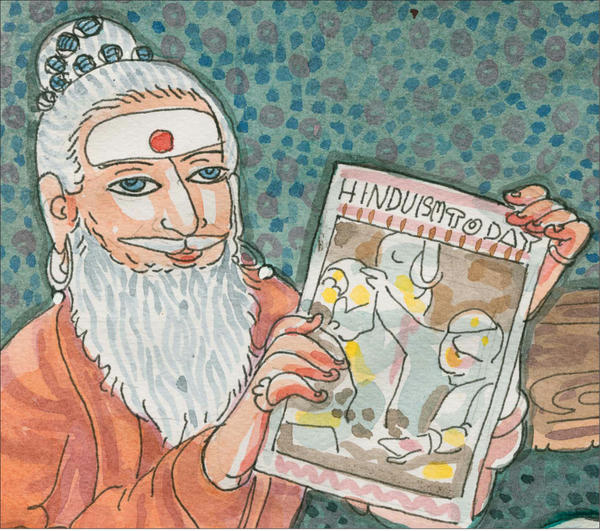
In 1979 Gurudeva founded the magazine that would later be called HINDUISM TODAY, telling his monks that its purpose was not to promote his mission, but to strengthen, connect and inform Hindu communities around the globe. He called it “the prow of the ship.”
• • • • • • • • • • • • • • • • • • • • • • • •§
We know that the term church will, in some communities, carry great respect and power, and in other communities it may be demeaned and belittled. Knowing theirs is the world’s first Hindu church on the planet, our members use the name Saiva Siddhanta Church (or its equivalent as traditionally rendered in the world’s many languages) boldly in all instances, defending its use when needed. Finally, it must be emphasized that while we adhere strongly to the institutional structure of church, we do so to most effectively convey the pure, traditional Sanatana Dharma as expressed in the Vedas. As one of the world’s most orthodox congregations, our use of this institutional structure should never be misconstrued as carrying or even implying any Christian or Western religious content.§
While the Greek-based word church is most commonly understood as a place of worship, the full meaning encompasses the religious congregation and organization on many levels of activity. Church takes on special importance in legal and governmental discussions, where matters of church and state are frequently focused on. In more and more nations, in federal and state governments, religion is defined as church, and the separation of church and state is respected and constitutionally enforced. Such protections, grounded in the concept of church, are crucial to the rights of all religious groups. These include protection from government and from other religions which may seek to dominate faiths with less political power. §
Gurudeva was clear on cardinal guidelines in administering his institution. First, the satguru and his monastics would be completely in charge; there would be no family involvement of any sort in the running of the Church. Second, no relatives of the guru or the monks would have any special access, privilege or participation in the administration. Third, the Church would not support itself through running businesses but rather be supported by donations. Fourth, his monasteries would be strict cloisters for men only. §
Publishing Goes Digital
Late one afternoon in 1985 Gurudeva entered a little computer store in the historic town of Kapaa. After playing with a state-of-the-art Macintosh for a while, he bought one for himself. Computers had never much interested him, but this one seemed different, friendly, approachable. For a week he experimented with it, calling the monks into his office every time he discovered a new feature. §
The guru and his shishyas learned the computer together, side by side. Seeing its potential, he ordered one for each of his monks, instructing them to adapt their various services to this new tool. And did they. From that day forward, the monks saw that their satguru always had the newest, fastest, sleekest Macintosh on his desk; and from the release of Apple’s first PowerBook, fellow airline passengers would gaze covetously at the holy man’s cool laptop.§
Going headlong into the world of computers to do the work of dharma proved a strategic move of prodigious proportions. In order to fully embrace the new technology, Gurudeva decided that his order of monks would need to sell the 2,500 colonies of bees, since the small publications team, which was doing both, had limited manpower. The monks had managed the bees island-wide for ten years on Kauai as an agricultural endowment, much like the farming enterprise Yogaswami had started in Batticaloa, Sri Lanka, for his young men followers. §
One of Gurudeva’s most strategic and looked-forward-to duties was writing his Publisher’s Desk column for HINDUISM TODAY, which for many years was monthly. Frequently he addressed matters that were brought to his attention through his personal ministry with devotees, students and members around the world. §
In 1983 he came upon a way to solve the problem that Hindus throughout the diaspora were having with Christmas. Hindu kids were upset, and their parents were in a quandary. And no one in the Hindu world was providing a viable answer to the annual torture. In one Publisher’s Desk, Gurudeva announced the inauguration of a modern Hindu holiday, to be called Pancha Ganapati. It was five days of worship, sharing and gift-giving, celebrated from December 21 to 25, focusing on Lord Ganesha’s five shaktis, which bring harmony in the home, among friends, in the workplace, in the community and the boon of religiousness and refined culture that this harmony brings. Now when children asked mom and dad, “Why don’t we get presents during Christmas?” they could answer, “We do, and not on just one day, but on five days.” Gurudeva wrote: §
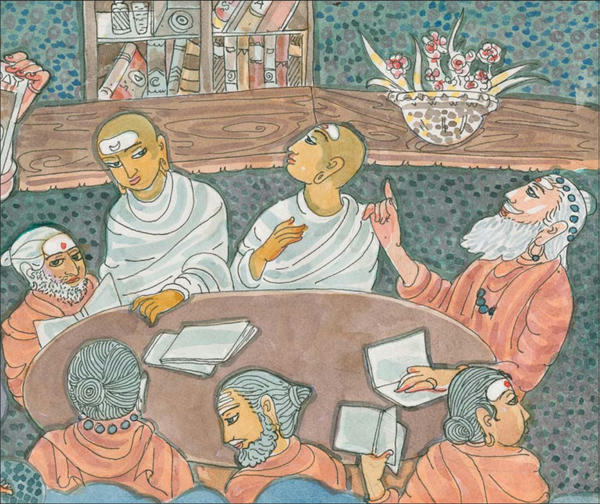
Each month Gurudeva sat with his HINDUISM TODAY editorial staff. As publisher, he guided the content of the magazine, defined its goals, set policy and helped with distribution strategies.
• • • • • • • • • • • • • • • • • • • • • • • •§
“Daddy, why don’t we have Christmas?” That question was heard in so many Hindu homes we visited that, in cooperation with scholars and elders, an alternative for Christmas was conceived. It’s interesting that in 1966 the Afro-American community created Kwanzaa, a social, Black-identity, earth-based festival celebrated each year from December 26 to January 1. Our own Pancha Ganapati is a festival to the five-faced elephant God. It is five days of gift-giving and festivities within the home, especially for the children. There is no need for a tree (eco advocates appreciate this), nor wreaths, nor a Santa. Lord Ganesha does it all, in five days of merriment and mirth. §
Those who have taken up this home festival from December 21st through the 25th have enjoyed it year after year. It can include outings, picnics, feasts, exchange of cards and gifts with relatives, friends and business associates. Each day a tray of sweets, fruits and incense is offered to Pancha Ganapati, often prepared and presented by the children. Chants, songs and bhajans are sung in His praise. After puja, sweets are shared as prasadam. Each day gifts are given to the children, who place them before Pancha Ganapati to open only on the fifth day. Greeting cards are exchanged, always offering Hindu wisdom or verse from scripture.§
As HINDUISM TODAY became his central outreach effort, Gurudeva focused his editorials on issues that were generally shrouded in silence, using his journal to guide the modern Hindu mind in how to dharmically approach matters like spousal abuse, suicide, adultery, pornography, mixed marriages, organ transplants and human cloning. The latter led to an invitation from President Bill Clinton’s Blue Ribbon Committee on human cloning for Gurudeva to define the Hindu view for legislators confronting the issue. Years later, the Texas Medical Association asked the magazine to write a chapter in their book on medical ethics to guide US doctors in their care of Hindu patients. §
Gurudeva took special delight when the editor of Christianity Today approached the editors of his journal to develop an article that would inform Christians about Hinduism. It was something of a dream he never had: Christianity Today working with HINDUISM TODAY to better understand their respective faiths. He guided the development of the article in every detail. In fact, that was his way with almost every article, which he kept close to through detailed and frequent discussions with his monks. §
In late 1996 Gurudeva transformed HINDUISM TODAY from its original newspaper format into a magazine, a quantum leap that extended its global reach and impact in Hindu communities. In 1999 he described his vision for this unique journal:§
Who could ever conceive of a journal founded to help everyone, to support every sect? For a long time it was a mystery to everyone, until the realization came that this was our public service. Most monasteries, or mathas, have established feeding centers for the poor, orphanages, schools and hospitals as their way of paying back for the privilege of being allowed to live aloof and apart from the world. Ours is HINDUISM TODAY: a much-needed service as we march boldly into the 21st century.§